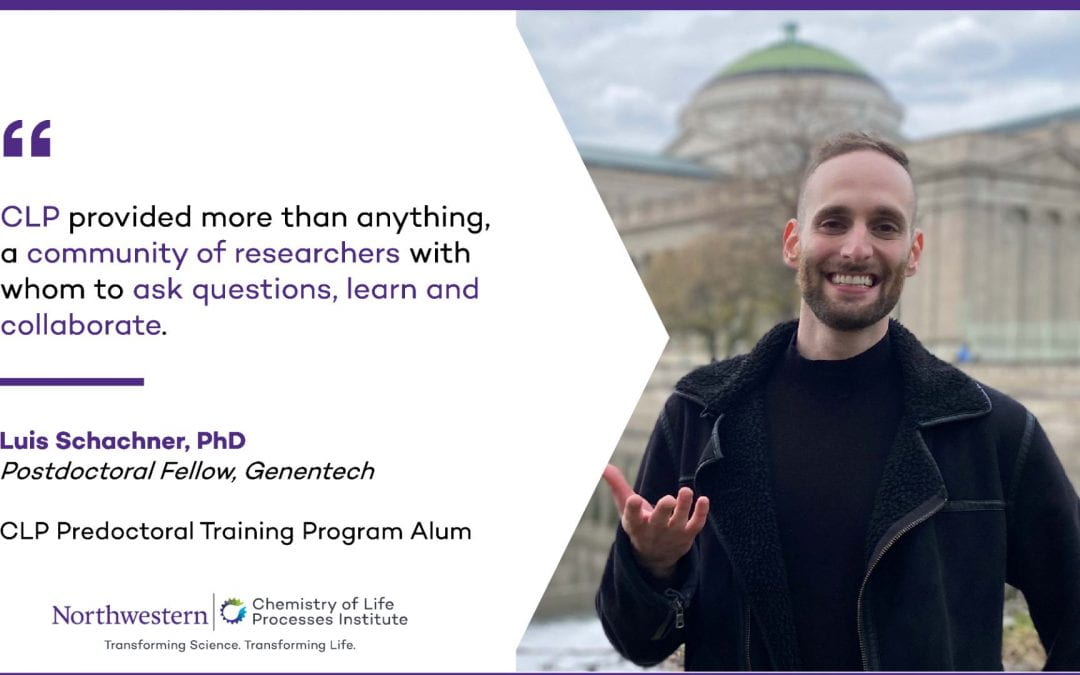Meet Luis Schachner, Post Doctoral Fellow at Genentech. CLP Predoctoral Training Program alum and graduate of Northwestern’s Chemistry Program. His CLP Training Program Preceptors were Neil Kelleher and Yuan He. Luis also served as CLP’s inaugural Artist-in-Residence.
What was the focus of your pre-doctoral research?
My initial emphasis was combining native mass spectrometry with cryo-EM. Then, I started working with Amy Rosenzweig, who was a member of my thesis committee. Amy studies metal bound enzymes and these metal cofactors influence activity and structure of these enzymes. So many of her questions are: How many metals are bound? Where are they bound? What kind of metals? I found many ways to use mass spec methods to answer those questions. That turned into five different papers with Amy’s group. One of which was the focus of my thesis chapter about localizing metals on an enzyme that eats methane and how that is being considered as a way to sequester methane from the atmosphere.
Yuan provided another very expert voice for experiments related to epigenetics (elements that are not coded in the genome). One project was examining nucleosomes and developing different methods for that. Another project was finding nucleosome transcription factor complexes and taking a picture of them with cryo to see if we can say anything about their structure and their binding.
I like to think of the genes as the ingredients in a recipe book and the epigenetics as the instructions on how to put it all together and make a dish. The nucleosome is a building block in chromatin–chromatin being this assembly and packaging mechanism that the DNA has within the cells. There is a lot of value in knowing how each nucleosome is unique or different from each other, how they cooperate and how the local environments within chromatin are defined from a modification point of view, from a DNA sequence point of view, and other insights.
In my thesis, I essentially defended the idea that mass spec opens up really interesting lines of investigation across structural and primary sequence lines. With proteomics, we can identify the proteins, but with structural mass spec methods, we can understand their spectral dynamics and behaviors in the gas phase, and some aspects of their structure . That helps us correlate the gaseous behaviors that we see with simulations and computational methods that actually look at that kind of time-dependent behavior of proteins.
What drew you to your first job out of grad school and what are you doing now?
I was drawn by the amazing resources available at Genentech and by my postdoc mentor who has been supportive of my science career since I interned there during undergrad. I will be looking at the intersection of mass spectrometry and structural biology as applied to interesting receptors and membrane proteins.
How did CLP support your journey?
CLP provided, more than anything, a community of researchers with whom to ask questions, learn and collaborate. Something that I enjoyed the most about science is how collaborative it is, and how collaborative it can be. Through my research, I was able to answer many people’s different questions. I really liked that when someone comes to me and they’re really passionate about their project, it helps me feel passionate about that as well, and about the analysis, and that’s really rewarding.
The fact that CLP is thinking about ways to bring scientists together, especially trainees around something like improvisation, was very helpful and validating in terms of my experience and how I wanted to create community in science. It was definitely part of what inspired me to think about art as another nexus for scientists.
What was a highlight of your time at Northwestern?
Sitting by Lake Michigan on campus was the highlight of my time at Northwestern. So much inspiration and peace!
by Lisa La Vallee
